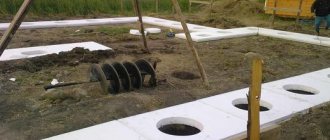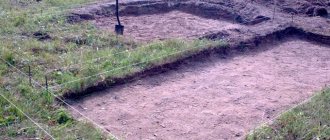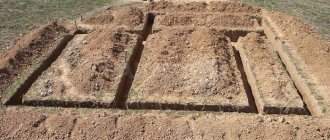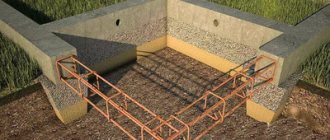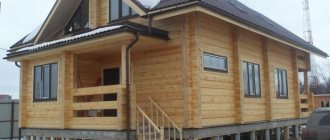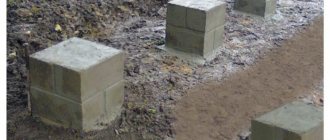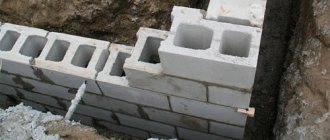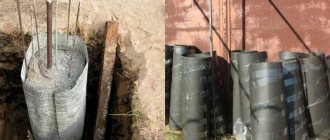Installing a greenhouse on piles
Add to favorites
A greenhouse made of polycarbonate and glass is in great demand among summer residents for its practicality and excellent quality. For its stability, it is necessary to install a reliable foundation in the form of screw piles or beams. How to choose the right site for a greenhouse, what tools you will need to lay the foundation, as well as step-by-step instructions for making it, are presented below.
Types of foundations for a greenhouse
As for building materials, in this case you can take wood (timber), brick, concrete mixture, as well as ready-made concrete slabs or blocks. Each option has its own advantages and disadvantages that must be taken into account when choosing a foundation.
Prices for concrete slabs
Table. Advantages and disadvantages of different types of foundations.
To choose the right base design for a greenhouse, you must follow the following rules.
Important! Another important point is that the reliability and strength of both the foundation and the entire greenhouse depend on strict adherence to the construction instructions and the correct execution of all work.
Pros and cons of installing a pile
A pile foundation can be laid in areas where the soil is weak and there is low groundwater, which is one of its main advantages. Piles can also be used on hard soils, where it is impossible to use another type of laying the base for a greenhouse.
This type of foundation is easier to dismantle, which is also a plus. The only drawback of the pile base is the complexity of its construction.
What do you need for work?
To build a good foundation and frame for a greenhouse, you need to choose the right place for construction, as well as select the materials from which the greenhouse will be built. What to look for when choosing a material and what tools you should definitely have with you during installation work, read below.
Material and tool
The greenhouse frame is made of the following materials:
- glass;
- polycarbonate;
- film.
It is best to opt for a polycarbonate building. This material, unlike film, is stronger and more durable. The glass frame is too heavy and fragile, which creates additional load on the foundation and complicates its installation.
In order to build a foundation, you need to prepare the following tools:
- a shovel to level the area;
- magnetic level to determine the vertical level of the pile;
- roulette;
- sledgehammer;
- a screwdriver with an attachment for a Phillips screwdriver and an 8 mm deep bit;
- marker for marking;
- gloves made of dense material so as not to injure the skin of your hands when working.
Selecting a location
Before installing a pile foundation, you need to choose a suitable location for its location. The site for construction should be well-lit and spacious so that the greenhouse is always in direct sunlight. You should not build a structure in an area where there is strong wind, because this will affect the stability of the greenhouse.
The site must have a high groundwater table. If there is an underground flow at a level of 1 m, then dehydration work should be carried out, which consists of forming a special embankment of sand, crushed stone and soil in order to create a hill at the site where the pile is installed.
Blueprints
Below is a ready-made drawing of a pile foundation that you can use when carrying out work:
Where to place the greenhouse correctly on the site
The installation of a greenhouse depends on the general parameters of the site. It is advisable not to carry out installation in places with high groundwater levels. If there is no other possibility, then a little additional work on dehydration will be required. To do this, an embankment is made from a mixture of sand and crushed stone. Then a massive layer of soil is laid on top.
Basic material for building greenhouses:
- glass;
- polyethylene films with a sufficient level of density;
- polycarbonate
The film is attractive due to its price, but it has a minimal service life - often it does not even last 3-4 seasons.
Glass is a fragile material and also places a significant load on the structure.
Cellular polycarbonate is the best option in combination of price/quality. Quite lightweight, very durable and with proper care will withstand more than 10 years of use.
Photo 2 Cellular polycarbonate
The color of cellular polycarbonate is of great importance for plant growth.
Shape and size
The most popular forms used in the construction of greenhouses are gable and arched structures. This makes installation easier and ensures stability and strength of the structure.
Step-by-step manufacturing instructions
Instructions for installing a pile foundation under a greenhouse manufactured by a ready-made greenhouse factory. Foundation dimensions - 3x4 m.
Video: assembly and installation of a polycarbonate greenhouse on piles
To make the base you will need:
- 14 piles 70 cm long;
- profile 2 m long - 4 pcs.;
- profile 1.5 m - 4 pcs.;
- self-tapping screws - 56 pcs.
Step-by-step instructions for installing a finished base for a greenhouse:
- To begin, unpack the greenhouse components, presented in the form of 4 pieces of profile pipes. 2 m each are the lower base and guides, which are assembled on the site.
Take the connecting bars and fasten the profiles together, thereby obtaining 2 pipes of 4 m in length.
Next, install T-shaped piles on the lower base of the greenhouse, there should be 5 of them for each 4-meter profile. Fastenings must be made in such a way that 2 fastenings are at a distance of 10 cm from the edges, 2 more in the middle of the lower base and 1 at the joint under the brand.
Fix the piles with 4 screws. for one fastener.
Move the bottom base to the location where the greenhouse will be located.
Dig holes for the foundation, approximately 30–40 cm deep. They should be located at the same distance as the piles on the structure.
Insert the structure into the dug holes and drive them into the ground to the bottom anchor using a sledgehammer and a wooden beam. The work must be done carefully so as not to damage the profile pipes.
How to install: step-by-step instructions
When installing a greenhouse on piles, you must choose a suitable location . The place needs to be well lit by sunlight. You cannot place it where there are often strong winds. This may make it less stable.
It is important to consider the groundwater level. If they are too close to the surface (less than 1 m), you will need to first make an embankment. The foundation must have a depth greater than that to which the soil freezes. If there are several layers of soil, then it is necessary to rely on the strongest of them.
First you need to draw a plan for the location of the piles. Then marks are made on the ground in the right places.
When installing piles with your own hands, the following methods can be used:
Screw piles are screwed into the ground using a drill or using special equipment.- Driving elements - pipes or channels are driven in with hammer blows.
- Piles can be placed in holes prepared with a drill. In this case, a cushion of sand and gravel is made from below for them, and a solution is poured into the hole around the pile.
It is important to choose the right distance between them. It depends on the weight of the entire structure. Usually it is 1.5-2.0 m. They try to install the piles strictly vertically. This needs to be checked using a building level. It is necessary that the upper ends are at the same level.
After the piles are installed, if concrete was poured for this, you must wait until it sets well. It takes 28 days to dry completely. However, they usually wait no more than ten days. After this, the pillars need to be fastened horizontally. This can be done using horizontal bars.
If a wooden beam was used, then the horizontal fastenings are made of wood . The parts are fastened using self-tapping screws. Metal parts can be fastened by welding. Sometimes, instead, they make a grillage - a horizontal structure lying on piles and forming the basis for building a greenhouse.
If the piles are made of concrete, then the grillage should be the same. If wooden or metal parts are used, then it can be made from timber.
Pile foundation for a polycarbonate greenhouse
Regardless of whether the greenhouse is purchased from polycarbonate or you plan to build it with your own hands in a certain place, it is necessary to build a high-quality reliable foundation so that it is not pulled out of place by the wind and carried to neighboring areas or even further.
If a polycarbonate greenhouse is used both in summer and winter, you should make a solid foundation for it, which will not be easy to keep the structure in one place, but also to isolate the walls from contact with the ground, through which the cold passes.
Common types of greenhouse foundations:
- a foundation made of timber, which can be easily dismantled along with the greenhouse;
- block foundation made of FBS, quite expensive, but solid;
- tape is also not the cheapest option;
- columnar: economical and quick to erect.
If the greenhouse is operated seasonally: from early spring to autumn, then a more economical and inexpensive pile foundation will be sufficient.
Pile foundation for a polycarbonate greenhouse
The pile foundation is distinguished by its strength and simplicity of construction, practicality and functionality. Its arrangement does not require leveling the ground or a large amount of excavation work. The technology for installing piles for a greenhouse is no different from the technology for installing piles for a fence or carport. Several types of pile foundations can be distinguished:
- pile made from ready-made piles (metal, wood, etc.), which are installed mainly by driving;
- screw from screw piles that require special devices for tightening.
Advantages of a pile foundation
Pile foundations for greenhouses have many advantages:
- does not require a large amount of ground work;
- installed on any type of soil;
- installed in 1 day;
- can be installed by two people without the use of special equipment, but with some homemade devices;
- immediately after installation, you can begin installing the greenhouse on the foundation;
- durable and reliable;
- durable;
- mobile: when moving the greenhouse, you can pull out the piles and move them to another place;
- economical: much cheaper than strip and other types of foundations.
The best option for installing a pile foundation for a greenhouse is when the owner of the site, even during the construction of the house, when driving piles for the foundation of the house, prudently draws a design for the site and drives piles: for a fence, for a gazebo, for a parking shed, and including for a greenhouse.
How to make a foundation on stilts for a polycarbonate greenhouse with your own hands
First, the pile field is prepared. Places for installing piles are marked. For an average size greenhouse, 6–8 piles installed in the corners and 1.5–2 meters apart will be sufficient. For a 6 by 3 greenhouse, 6 piles will be enough.
Piles can be driven in with a sledgehammer, holes can be drilled with a drill and piles are lowered into them, piles can be screwed into the ground using a homemade screwing device (there are quite a lot of such devices described on the Internet).
Features and characteristics of the foundation on piles
To construct a greenhouse, the piles are buried to the depth of soil freezing. Due to the lightness of the structure, the greenhouse can easily be squeezed out in winter by frost heaving forces. And the peculiarity of polycarbonate is that in the cold it becomes more fragile and may burst due to misalignment. Therefore, all measures must be taken to minimize the impact of frost heaving forces on the piles.
Screw piles for a polycarbonate greenhouse firmly hold the soil with their blades, compacting it as they twist under them. Therefore, no additional measures to strengthen it are required.
What is a pile foundation?
There are various options for constructing a foundation. Tape, block or other types can be used.
Pile foundation is not the most common choice, but, nevertheless, it is also successfully used. Piles for greenhouses are produced in various versions.
They may vary due to the following features:
- According to the internal structure: solid or hollow elements are possible.
- Shape: can be pyramidal, cylindrical, square or rectangular.
- They are made from various materials. Concrete, wood or metal can be used.
Prefabricated metal structures are available for sale. They contain not only piles, but also horizontal connections between them. After installation, this kit will become a reliable basis for the greenhouse.
Pros and cons of such a basis
The advantages of installing a pile foundation for a greenhouse are as follows:
strong wind or rain will not be able to move the structure;- the use of a foundation creates a gap with the soil that prevents the penetration of pests;
- the use of piles makes it possible to install a greenhouse where the soil is inclined;
- the foundation protects plants from the entry of ground moisture, which can contribute to root rotting;
- this option will allow you to make a greenhouse in a swampy area - it is necessary that the depth of the piles be such that they reach solid ground;
- it helps retain heat for plants and saves heating costs;
- extends the service life of the structure, limiting the harmful effects on it.
Sometimes its use is not necessary. For example, for small greenhouses its use is not necessary. The use of wooden beams can only be considered as a temporary solution due to its fragility. Such connections are easy to install or move to a new location, but they are gradually destroyed by moisture.
Since free space is formed under the greenhouse, cold can penetrate through it. To fix this, they make a strapping, closing the gap around the entire perimeter.
Area and conditions of application
Typically, the materials for making greenhouses are film, polycarbonate or glass . The structure can be erected without a foundation, but in this case problems may arise. Due to groundwater or when snow melts, the structure may sag and become deformed. This is true for greenhouses made of polycarbonate and glass.
On strong and reliable soil, the likelihood of displacement occurring is less, but it does exist. If the soil is weak and the groundwater level is low, then a foundation will be necessary. It is considered the most effective and less expensive option.
This article will tell you about the pile foundation for a polycarbonate greenhouse.
Types and cost of installing piles used for greenhouse construction
Screw piles for a greenhouse are a reliable and proven way to ensure the stability of a structure in any climatic conditions and to protect against unforeseen weather disasters.
Putting a greenhouse house directly on the ground is cheaper, but it’s worth calculating how much repairs will cost if it’s knocked over by the wind, and the advantages of piles will immediately become obvious.
Monolithic slab foundation
Now let's look at the stages of creating such a foundation.
Step 1. Mark using pegs and rope. Particular attention should be paid to controlling the diagonals and perpendicularity of the sides.
Step 2. Dig a pit at least 50 cm deep.
Step 3: Add layers of sand and gravel. Their total thickness should be 25-30% of the pit depth. Compact them and, if necessary, cover them with geotextiles.
Step 4. Install formwork around the perimeter of the pit. Fill the space between it and the ground with gravel.
Step 5. Install fittings and drainage pipe.
Step 6. Pour concrete to the edge of the formwork. This stage is very important and requires a professional approach - it is necessary to ensure a perfectly even screed. Insert anchor bolts or other fasteners for the greenhouse frame.
Step 7: Wet the concrete for a week.
By the way! It will be interesting to know: Foundation for a barn with your own hands: from preparation to construction
Step 8: Next, let the foundation slab set. This usually takes 3-4 weeks, but in warm and dry climates the process will go faster.
Step 9. Remove the formwork and fill the gap between the slab and the surrounding ground with crushed stone.
Varieties
A greenhouse, built by yourself or purchased ready-made, is usually built on a foundation.
The owner of a useful building has several foundation options to choose from:
- easily dismantled from timber,
- blocky,
- tape,
- columnar.
All of them are quite reliable, but the pile type is also considered the most practical, inexpensive and easy to implement.
According to experts, the technology for installing piles is practically no different from installation for a fence or carport. Columnar and strip ones require much more money and time, but pile ones are not inferior to them in reliability.
Differentiation of the main constituent elements is carried out according to:
- Material of manufacture – there are those made of lumber, metal or reinforced concrete.
- The cross-sectional shape of the piles – and for sale there are round, rectangular, multi-faceted, pyramidal type.
- Of no small importance for stability is the hollowness or solidity of the acquired devices for reliable arrangement.
- It doesn’t hurt to find out when purchasing the ability to withstand ice levels, extreme temperatures, and the ability to resist metal surfaces (if they are metal).
Greenhouse construction process
Advice. It is best to use greenhouses without a foundation on soils that have a fairly high density (clay and chernozem soils). It is also worth considering the size of the structure. without a foundation it should not be very large.
DIY greenhouse construction
Advice. In very hot times, as a rule, it begins in mid-summer, the greenhouse is covered with a protective film so that the sun's rays do not damage the leaves of the plants.
- A foundation for a greenhouse will be necessary if the structure itself is made of polycarbonate or other heavy finishing material that is intended for such purposes. The most commonly used foundation is a pile foundation, which is distinguished by its strength and ease of construction.
- If you build a greenhouse yourself, the price of such a structure will be quite low, which helps save the family budget. The process itself is very simple. It will be necessary to draw up a detailed plan for future work.
Pile foundation for a greenhouse
- According to the internal structure (solid and hollow).
- According to geometric shape (round, pyramidal, rectangular).
- According to the material from which they are made (metal, wood, reinforced concrete).
Installation of the pile foundation can be done independently. For this, there are a large number of methods that allow you to make a solid foundation for a greenhouse in a short time.
Pile foundation for a greenhouse
Advice. A hand drill is best used at the very beginning of the drilling process. With its help, you can pull out excess soil from the hole, thanks to its blades.
Then pre-made concrete solution is poured into the drilled “wells”. It consists of:
The concrete calculation is based on preparing a solution of 1 bucket of cement to 3 buckets of sand. It will be more convenient to mix the solution using a concrete mixer, which can significantly save time on building the foundation. So:
DIY pile foundation
Advice. A pile-type foundation for a greenhouse can be made if the groundwater level is low enough. Such measures will protect the base of the greenhouse from flooding and deformation.
Which ones are better to use?
There are no clear recommendations in this matter , because piles are installed for greenhouses from different building materials. There may be options of large dimensions, or mini-structures, for your own needs. The terrain and the estimated depth to which the excavation will be carried out are also important.
For residential buildings, large-diameter pipes are more often used, but the construction of a greenhouse can be made from polycarbonate, glass or film, with a gable roof or in the form of an arch, in areas with different terrain. Often for light buildings the smallest size is taken.
If the design is planned to be heavy, it is better to take a larger diameter and thickness. All these features are taken into account when choosing the pipe diameter, tip type and number of blades.
Deciding on the location and material
The next important point is that it is not advisable to assemble a greenhouse on a pile foundation in places where there is a high level of groundwater flow.
In cases where the choice of location is limited, it is necessary to first carry out the dehydration process. Its essence lies in the initial arrangement of a sand and crushed stone embankment, on which a good layer of soil is subsequently placed.
Polycarbonate is quite flexible and durable
To assemble greenhouses, materials such as:
Each of them has its pros and cons. For example, film is much cheaper in price, but is not durable. Glass is a fragile material.
Polycarbonate is the best option both in terms of price and service life for greenhouse assembly.
When choosing polycarbonate to cover a greenhouse, consider such important features as transparency and color. Each of them should not prevent the free penetration of sunlight into the greenhouse.
The most common and convenient for operation are greenhouses, arranged in the form of an arch or with a gable roof.
Some greenhouses try to be built on a foundation when arranging durable structures.
By the way! It will be interesting to know: Calculation of the foundation of an inverted bowl
What type of foundation to choose or in what way it should be laid is decided in each case individually.
Dimensions and prices for turnkey installation
The price of installation depends on several components - the length of the pile and the size of the blade, tip and reinforcement, as well as on the expected number of elements and the type of tip used.
The cost of turnkey installation includes:
- delivery to place,
- marking,
- deepening,
- trimming trunks (if necessary),
- installation of timber or channel.
If any of the stages is undertaken by the customer:
- delivery,
- channel installation,
- markup work,
You can make the process a little cheaper, although it all depends on the circumstances and the time spent.
With welded tip
A welded tip is the best option for soft soil , since it is made by cutting wedges from a pipe in order to then give its end a cone shape.
Welding is a durable method of joining, but it is believed that the seams may come apart when encountering hard areas of soil.
The table shows approximate prices, taking into account several components:
| Length | Blade diameter | Head size | Price for one |
| 1000 mm | 200 mm | 200 mm | 850 rub. |
| 1500 mm | 200 mm | 200 mm | 900 rub. |
| 2000 mm | 200 mm | 200 mm | 1000 rub. |
With molded tip
Cast tip is the optimal solution for hard soil types . It uses durable steel and reliable fastening to the base. But the feasibility of use is determined taking into account additional components, since the difference in price is noticeable.
Installation pricing table:
| Length | Blade diameter | Head size | Price |
| 2000 mm | 300 mm | 200 mm | 1300 rub. |
| 2500 mm | 300 mm | 250 mm | 1600 rub. |
| 3000 mm | 300 mm | 250 mm | 1650 rub. |
Reinforced
They are in demand during the construction of a residential building, especially on problematic soil or in difficult climatic conditions.
The cost of installation work for greenhouses is not very affordable, but sometimes it makes sense, especially if a capital structure is being prepared for industrial purposes and in regions with weather risks.
| Length | Blade diameter | Head size | Price |
| 1500 mm | 300 mm | 200 mm | 3450 rub. |
| 2000 mm | 300 mm | 250 mm | 3700 rub. |
| 2500 mm | 300 mm | 250 mm | 4000 rub. |
Everything you need to know about the design and construction of a pile foundation can be found here.
Wooden beam foundation
The most common type of foundation for a cellular polycarbonate greenhouse is a wooden beam structure. This design has the following advantages.
- Low cost and construction time - it is impossible to create something faster and for a lower price.
- Minimum of parts and tools used.
- Working with wood is relatively simple.
- No need for overly tight sizing control.
- After arranging the foundation, you can immediately begin assembling the greenhouse.
- Easy to dismantle the foundation, repair it or move it. The latter is especially true for those summer residents who constantly move the greenhouse from depleted soil to a new place on the site.
To build a timber foundation you will need the following materials and tools:
Step 1: Clear the area of debris, tall grass and rocks.
Step 2: Level the area.
By the way! It will be interesting to know: Features of a slab foundation
Step 3. Using pegs and a stretched rope, mark the outer and inner edges of the foundation.
Step 4. Dig a trench according to the height and depth of the beam.
Step 5. Level the walls of the trench, fill the bottom with a layer of sand or gravel (25% of its depth).
Step 7. Measure and mark the length of the timber, taking into account the method of fastening (on corners or “half-tree”). Then cut with an electric jigsaw or saw.
Step 8. Treat the material with an antiseptic and let it dry.
Step 9. Assemble the timber into a rectangular box without joints, check the lengths and diagonals with a tape measure.
Step 10. Connect the structural elements to each other. If dowels are used for this, make cuts in the timber and drill holes for fasteners.
Step 11. Place the timber box in the trench. Please note that the weight of the structure can be from 150 kilograms or more, so carry out the work with several assistants.
Step 12. Fill the gap between the timber and the walls of the trench with sand. On top of the foundation you can lay waterproofing made of roofing felt or other coating with the same characteristics.
After completing all twelve steps, you can begin installing the greenhouse frame on the foundation.

